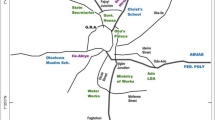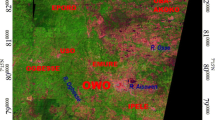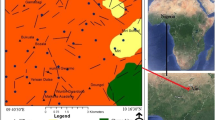Abstract
Groundwater prospect in parts of southwestern Nigeria was delineated by inferring the subsurface models from the responses of remote sensing and GIS data. In characterizing the area, both primary and secondary data were used. The primary data include landsat8 OLI and ASTER Digital Elevation Model, while the secondary data includes geology, soil, and topography maps of the area. Hence, thematic maps of potentials and lineament density, and land cover/use maps for the area were derived from the landsat8 OLI/TRS image. Thus, the area was characterized as follows: very low, low, moderate, high, and very high potentiality that covered 1.4 km2 (0.59%), 72.18 km2 (9.59%), 372.3 km2 (49.44%), 272.12 km2 (36.14%), and 35 km2 (4.64%), respectively. The western part of the area is dominated by very low to low potential, while the southern part of the area is dominated by high to very high potential. Hence, low and moderate potentials occupy the highest landmass (59.03%) in the area. In conclusion, the basement complex terrain in question has a moderately low aquifer capability.












Similar content being viewed by others
Availability of data and materials
The data are available upon reasonable request.
Code availability
Not applicable.
References
Adelana SMA, Olasehinde PI, Bale RB, Vrbka P, Edet AE, Goni IB (2008) An overview of the geology and hydrogeology of Nigeria. Appl Stud Africa 11(55):171–197
Ademilua OL, Olorunfemi MO (2000) Integration of hydrogeophysical and remote sensing data in the assessment of groundwater potentials of the basement complex terrain of ekiti state so
Bayowa OG, Olorunfemi MO, Akinluyi FO, Ademilua OL (2014) Integration of hydrogeophysical and remote sensing data in the assessment of groundwater potential of the basement complex terrain od Ekiti State, Southwestern Nigeria. Ife J Sci 16(3):353–363
Bouwer H (1978) Hydrology. McGraw-Hill Book, New York, p 480
Davis SN, De Weist RJM (1966) Hydrogeology. John Wiley & Sons, New York
De Reu J (2013) Application of the topographic position index to heterogeneous landscapes. Geomorphology 186:39–49
FAO (2005) AQUASTAT-FAO’s information system on water and agriculture in Nigeria, Water Report no. 29. Food and Agricultural Organization, Rome
Fashae OA, Tijani MN, Talabi AO, Adedeji OI (2014) Delineation of potential zones in the crystalline basement terrain of SW-Nigeria: an integrated GIS and remote sensing approach. Appl Water Sci 4:19–38
Ghodratabadi S, Feizi F (2015) Identification of potential zones in moalleman, iran by remote sensing and index overlay technique in GIS. Iranian J Earth Sci 7:142–152
Gupta RP (2003) ISBN 3540431853, 9783540431855. In: Remote Sensing Geology. Springer Science and Business Media, pp. 532–533
Kia MB, Pirasteh S, Pradhan B (2012) An artificial neural network model for flood simulation using GIS": Johor River Basin, Malaysia. 251–264
Nag SK, Kundu A (2016) Delineation of potential zones in hard rock terrain in Kashipur block, Purulia district, West Bengal, using geospatial techniques. Int J Waste Resour 6:1–7
NIMET (Nigerian Meteorological Agency) (2019) Seasonal Rainfall Prediction. Available at: https://nimet.gov.ng/publication/2015-seasonal-rainfall-prediction
Obaje NG, Balogu DO, Idris-Nda A, Goro IA, Ibrahim SI, Musa MK, Dantata SH, Yusuf I, Mamud-Dadi N, Kolo IA (2009) Preliminary integrated hydrocarbon prospectivity evaluation of the Bida Basin in North Central Nigeria. Petro Technol Dev J 3(2):36–65
Okoli FU, Aiegbedion IP, Marcellinus LM, Oludiji SM, Idoko IA (2019) Potential Mapping in Ado Ekiti, Nigeria Using GIS and Remote Sensing Techniques. Int J Adv Res Public 3(3):18–21
Olasehinde PI (1999) An integrated geological and geophysical exploration for in the basement complex of west central Nigeria. Water Resour 10:46–49
Olayinka A (2012) Geoelectric parameters yielded the statistical evaluation of the groundwater potentials of Ado ekiti, southwestern Nigeria. Trans J Sci Technol 2(6):110–127
Olorunfemi MO, Fasuyi SA (1993) Aquifer types and the geoelectric/hydrogeologic characteristics of part of the central basement terrain of nigeria (Niger State). J African Earth Sci 16(3):309–317
Olorunniwo MA, Olorunfemi MO (1987) Geophysical investigations for in precambrian terrains: a case study from Ikare, Southwestern Nigeria. J African Earth Scis 6(6):787–796
Rahman MA (1976) Review of the basement geology of southwestern Nigeria. In: Kogbe CA (ed) Geology of Nigeria, 2nd edn. Elizabethan Publisher, Lagos, pp 41–58
Saminu O et al (1999) The use of vertical electrical sounding (VES) for groundwater exploration around Nigerian College of Aviation Technology (NCAT), Zaria, Kaduna State, Nigeria Pacific Journal of Science and academia
Sarup J, Takal KM, Mittal SK (2011) Estimation of soil erosion and net sediment trapped of upper-helmand catchment in Kajaki reservoir using USLE model and remote sensing e GIS technique. Int J Adv Eng Res Sci 4(2):237056
Funding
Not applicable. This research did not receive any specific grant from funding agencies in the public, commercial, or not-for-profit sectors.
Author information
Authors and Affiliations
Contributions
All the authors participated equally in the execution and production of the work.
Corresponding author
Ethics declarations
Conflict of interest
Not applicable. None of the authors has any declarations to make.
Additional information
Publisher's Note
Springer Nature remains neutral with regard to jurisdictional claims in published maps and institutional affiliations.
Rights and permissions
Springer Nature or its licensor (e.g. a society or other partner) holds exclusive rights to this article under a publishing agreement with the author(s) or other rightsholder(s); author self-archiving of the accepted manuscript version of this article is solely governed by the terms of such publishing agreement and applicable law.
About this article
Cite this article
Abubakar, H.O., Ige, O.O., Olatunji, S. et al. Characterizing groundwater potentials in parts of the basement complex of Nigeria using GIS and remote sensing. Sustain. Water Resour. Manag. 9, 50 (2023). https://doi.org/10.1007/s40899-023-00826-1
Received:
Accepted:
Published:
DOI: https://doi.org/10.1007/s40899-023-00826-1




